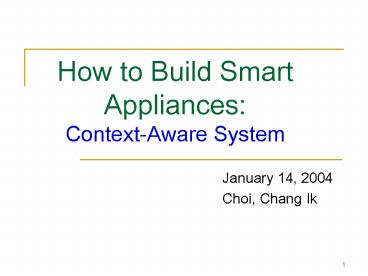How to Build Smart Appliances: ContextAware System PowerPoint PPT Presentation
1 / 15
Title: How to Build Smart Appliances: ContextAware System
1
How to Build Smart Appliances Context-Aware
System
- January 14, 2004
- Choi, Chang Ik
2
Overview
- Introduction
- Terminology
- Context Capturing Devices
- Constraints on Capture
- Architecture
- Building a Context-Aware Application
- Example
- Research Areas
- Thoughts
3
Introduction
- Smart appliances should
- Not be ignorant about the environment
- Have implicit human-computer interaction
- Work naturally
4
Terminology(1/2)
- Context Awareness
- knowledge about the users and devices state,
including surroundings, situation, and location - Situation (situational context) real-world
situation - Sensor data (situational data) data that is
captured to represent the situation - Context (context knowledge) abstract
description of the real-world situation - Context-aware/sensitive application
applications that change their behavior according
to the context (independent of sensor data)
5
Terminology(2/2)
Abstract representation of the situation
Real-world situation
Application
Abstraction
Sensor data
Context
6
Context Capturing Devices
- Light Sensors
- supply information on the light density,
intensity, reflection, etc. of the device - Accelerometers
- supply information on the inclination, motion,
or acceleration of the device - Location
- GPS, WLAN, GSM, etc.
- Passive IR Sensors (Motion Detector)
- for stationary devices movement of the device
itself is detected as well
7
Basic Assumption of Sensor-Based
Context-Awareness
- In a certain situation, specific sensor data is
frequently similar to sensor data of the same
situation at different times
8
Constraints on Capture
- Portability, Usability, and Design
- Power consumption
- Calibration
- Setup Time
- Reliability
- Price and Cost
- Unobtrusiveness
9
Building a Context-Aware Application
- Identify the contexts that matter check if
context matters at all (select a situation) - Find that appropriate sensors (select a context)
- Build and assess a prototypical sensing device
- Determine recognition and abstraction
technologies (independent of the real situation) - Integration of cue processing and the context
abstraction - Build applications
10
Architecture (1/3)
(Buffer)
(Buffer)
11
Architecture (2/3)
- Cues
- Provide an abstraction of physical and logical
sensors - Make changes of the hardware transparent to the
context recognition layer - Reduce the stream of data provided by the sensors
- To implement cues, use statistical functions to
get summary of the values over time or to extract
features form the raw data - Average, standard derivation, quartile distance,
base frequency, first derivative, time domain
values
12
Architecture (3/3)
- Contexts
- Description of the current situation on an
abstract level and is derived from available cues - e.g.) If (light is low and acceleration is
nonzero) then context Moving in the dark - AI methods and mechanisms are needed for
calculating context from the cues
13
Example (A Context-Aware Mobile Phone)
- Multiple configurations (profiles)
- Hand vibrate mode
- Table gentle sound
- Pocket loud sound
- Outside sound, as high as possible
- General when none of the above apply
14
Research Areas
- Cue Tuple Space to Context
- Finding the right cue for the context
- Context Tuple Space to Application and Scripting
- Finding the right context or group of contexts
for an application
15
Thoughts
- Considerations for selecting sensors and
algorithms - Power Consumption
- Size and Weight
- Price of Components
- Robustness and Reliability
- Discriminating contexts that should be dealt
implicitly and contexts that should be dealt
explicitly

